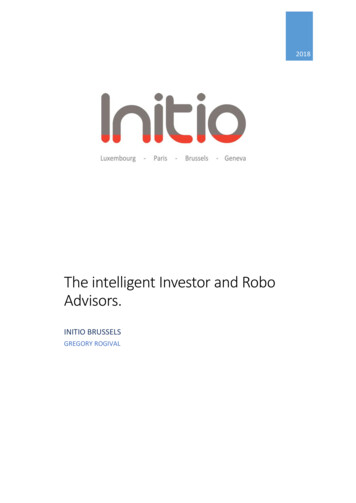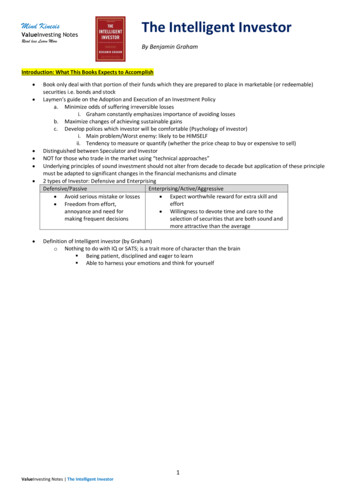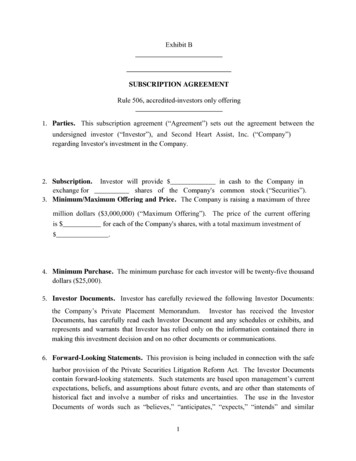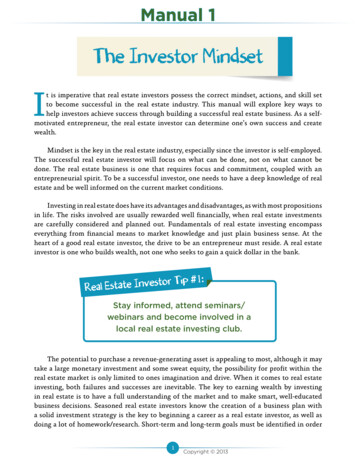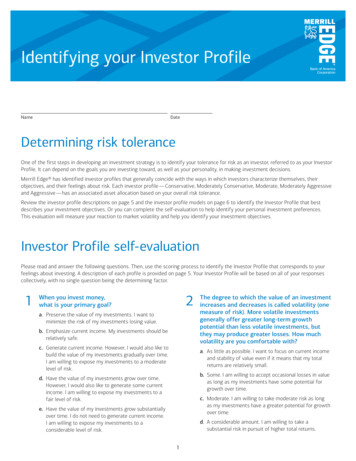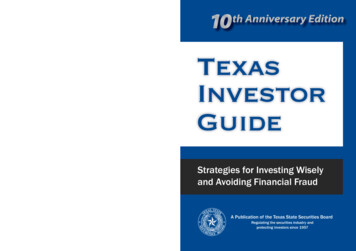
Transcription
TexasInvestorGuideTexas State Securities BoardP.O. Box 13167Austin, TX 78711-3167Strategies for Investing Wiselyand Avoiding Financial FraudTelephone: (512) 305-8301Toll-Free: (888) 663-0009Fax: (512) 305-8310www.ssb.texas.govSign up for news & updatesat www.ssb.texas.govFollow us onTwitter @TxSSBConnect with us atLinkedIn.com/company/TSSBFind us atFacebook.com/TexasSSBA Publication of the Texas State Securities BoardRegulating the securities industry andprotecting investors since 1957
Dear Texas Investor:Welcome to the 10th anniversary edition of the State Securities Board’s TexasInvestor Guide: Strategies for Investing Wisely and Avoiding Financial Fraud.More than 92,000 Texans have received the Investor Guide, and readers havepraised its no-nonsense approach, clarity, and breadth of information aboutthe time-tested principles of investing.The 2020 edition will continue to be distributed as a free, print book andavailable online in a PDF. For the first time, it is available as an e-book, whichcan be downloaded for your preferred reading device at ssb.texas.gov/eguide.The Investor Guide’s roots go back to the early 2000s, when then-SecuritiesCommissioner Denise Voigt Crawford started the State Securities Board’sinvestor education program.Ms. Crawford started a speaker program, led community outreach, andcreated a series of pamphlets on investing and fraud. That material coalescedinto the Texas Investor Protection Guide and then the book’s current title.The past decade has shown that investment fraud is a mix of tried-and-truescams—oil and gas, promissory notes, real estate, various stock and currencytrading schemes—and emerging threats.A decade ago, it would have been impossible to predict the investorhysteria over something like cryptocurrency offerings. In 2018, the StateSecurities Board effectively shut down an overseas, multi-billion-dollarcryptocurrency-lending program—and continues to combat fraudulentdigital offerings on an enormous scale.The Internet, particularly social media, has been weaponized by fraudstersto reach potential victims wherever they live and whatever their financialmeans.Texas’ aging population presents another challenge. The number ofinvestigations into suspected financial exploitation of vulnerable adults—those 65 and older or having a cognitive impairment—is the highest it’sever been.One thing remains constant: our commitment to providing best-in-classmaterial to help investors protect themselves.Sincerely,Travis J. IlesSecurities Commissioner
Texas Investor GuideStrategies for Investing Wisely and AvoidingFinancial FraudTexas State Securities Board2020 Edition
TOCTEXAS INVESTOR GUIDETAB LE OF C ONTEN T SINTRODUCTIONPART 1Facing Page 1WHY INVEST?Page 1Page 1Page 2Page 2Page 3Page 4PART 2MAKING INVESTMENTSPage 5Page 5Page 5Page 6Page 8Page 9Page 9Page 10Page 11Page 12Page 14PART 3PRINCIPLES OF INVESTINGPage 15Page 16Page 17Page 17Page 18Page 18Page 20Page 24Page 25Page 25Page 26Page 27Page 28Before Investing, Develop a Plan for Family Money ManagementThe Time Value of MoneyThe Rule of 72Investing for GrowthWhy People Don’t InvestAsset ClassesEquitiesFixed IncomeCash and Its CousinsReal EstateInvesting Through Mutual Funds and ETFsMutual FundsExchange Traded FundsActively Managed vs. Index FundsEstablishing an AccountInvestment RiskStrategies to Manage RiskAsset AllocationDiversificationAllocating Your PortfolioSample Portfolio AllocationsPortfolio ReturnsReallocatingRebalancingTarget Date FundsHow Investment Costs Affect Your ReturnThe Impact of Fees
TEXAS INVESTOR GUIDEPART 4INVESTING FOR A SECURE RETIREMENTPART 5AVOIDING SCAMS AND UNDERSTANDINGHIGH-RISK INVESTMENTSRetirement AccountsPension PlansSocial SecurityAnnuities401(k) PlansIRAsTraditional IRARoth IRAEmployer Plan or IRACash-Outs and RolloversThe Warning Signs of FraudWhen You Suspect FraudTop Threats to InvestorsSpendthriftsCryptocurrency Offerings Reach Main Street InvestorsTexas Case Studies of Investment FraudPART 6FINDING A FINANCIAL PROFESSIONALYOU CAN TRUSTPage 29Page 30Page 31Page 31Page 31Page 32Page 34Page 34Page 35Page 36Page 37Page 38Page 38Page 39Page 41Page 48Page 49Page 50Investment AdvisersBrokersRobo-AdvisersFinancial PlannersAlphabet Soup of DesignationsQuestions to AskPage 51Page 51Page 52Page 55Page 57Page 57Page 59TEXAS STATE SECURITIES BOARDREADING LISTPage 61Page 62GLOSSARY OF TERMSPage 63
INTRODUCTIONInvestors have more responsibility than ever for achieving their financial goals.When it comes to retirement, the days of corporations managing pension plans fortheir workers are dwindling, and have been for a long time. Social Security is expectedto replace less and less of the income a retiree earned while working. Instead, workersincreasingly have had to fend for themselves by setting up their own retirementaccounts or participating in the retirement accounts offered by employers, such as401(k) plans.This shift in responsibility requires us to know a lot more about making investments,yet too few of us really feel equipped to make informed decisions about our financialfuture.A Library of Congress report found that many investors “lack essential knowledge ofthe most rudimentary financial concepts,” such as the differences between stocks andbonds, the role of the stock market, and the value of portfolio diversification.Nor do investors appreciate how badly investment fees erode their long-term returns—or how to minimize those fees.When it comes to financial fraud, investors are consistently attracted to shiny newthings—very risky investments that promise to earn them big, big returns. And theydon’t pay enough attention to the alarm bells ringing in their heads before putting theirhard-earned money into one of the ever-evolving types of fraud.The Texas Investor Guide was written to help investors—beginning and moreexperienced—understand precisely these topics. And if you decide to seek a financialadviser, the Investor Guide will help you ask the right questions and do the necessaryresearch to increase your chances of finding a financial professional you can trust.To begin, let’s address a basic question: Why Invest?Back to Table of Contents
PART 1WHY INVEST?Why invest? The answer can be summed up in three points:1. You won’t meet your financial goals by burying your money in the backyard. Youinvest so you can buy a home, send your children to college, start your own business,or expand your horizons by continuing your own education or traveling.2. Your most important goal is likely to be enjoying a secure retirement. You help makethat possible by investing regularly. Investing supplements your savings and helpsyou cover your day-to-day costs, including healthcare expenses, over what could be adecades-long retirement.3. Investing helps provide financial security for your family, and for the people andorganizations that depend on your generosity.All investing carries some degree of risk, however, so it pays to learn the investmentbasics before you get started.BEFORE INVESTING, DEVELOP A PLAN FOR FAMILYMONEY MANAGEMENTIt makes little sense to start investing before you take the steps needed to make sureyour and your family’s financial house is in order. If you’re burdened by excessive debtthat is making it difficult even to save money, then you should probably address thatissue before stepping into the world of investments.Setting your family’s financial goals requires the same type of careful planning asinvesting does. Without a plan, it can take a long time to reduce excessive debt, whetherfrom credit cards, a mortgage, car loans, student loans, or other amounts you may oweto creditors. Paying off credit card debt that carries an annual percentage rate of 18%,for instance, will give you a better return than most investments.Besides reducing debt, families should try to build an emergency savings fund thatwould pay for at least three months of living expenses. This fund can help cover the costof unexpected events, such as unemployment, repairs or replacement of a car or majorappliance, prolonged illness of a family member, medical expenses not covered byinsurance, and property taxes.A publication from the Federal Reserve Bank of Dallas, Building Wealth: A Beginner’sGuide to Securing Your Financial Future, can take you step by step through the processof family budgeting, including building credit, controlling debt, preparing a spendingplan, calculating your net worth, and knowing which types of insurance are needed toprotect yourself from major financial losses. Building Wealth is free. Find out more atwww.dallasfed.org/educate.1Back to Table of Contents
THE TIME VALUE OF MONEYThe 1 you have in your pocket today is worth more than that same 1 will be worthnext month or next year. That’s the time value of money: The more time that goes by,the less value your money has.Money loses value—or buying power—as a result of inflation. Almost anything youbuy now costs more than it once did—and often more than you expect. Inflation is abig part of the reason it will cost you more to live in the future than it costs now. Whatmakes things worse is that over the past 40 years the average inflation rate as measuredby the Consumer Price Index (CPI) has risen much faster than people’s averagedisposable personal income (DPI). That means you have lost a lot of buying powerduring that time.Inflation also does real damage to your savings, especially if the inflation rate is higherthan the interest rate you’re earning. If that’s the case, your savings are actually losingrather than gaining value.So what’s the solution? You’ll need a source of income in the future that will outpaceinflation and close the gap between what things will cost and what you have to spend.Investments can provide that income.THE RULE OF 72The Rule of 72 shows howinflation can erode your income.Here’s how it works: You divide 72by the annualized inflation rate,which has averaged 3% since 1926.Since 72 3 24, you can expectyour living expenses to doubleevery 24 years.That’s an eye-opening number, since there’s nothing unusual these days about aretirement lasting 24 years. It’s critical, then, to have more income as time goes by. Keepin mind, too, that in some years inflation is higher than 3%. If inflation jumped to 6%, orsoared past 12%, as it did in the late 1970s, then the damage to your long-term financialsecurity could be severe.The Rule of 72 is also a quick and accurate way to estimate how quickly the money youinvest will double in value.For example, if your investment portfolio provided a 6% annualized return, youcould expect your account to be worth twice what you invested after 12 years(72 6 12). That’s even if you don’t invest another cent—though ideally youwould continue to add money to your portfolio every year.2Back to Table of Contents
One word of caution, though: No rate of return is guaranteed. The estimates providedby the Rule of 72 depend on assumptions about the rate of inflation and the rate ofinvestment return, both of which could differ significantly from historical averages oryour expectations.INVESTING FOR GROWTHIf the value of your investment portfolio increases more quickly than inflation causesprices to rise, you’ll increase your net worth and be more financially secure. One way todo this is to invest for growth, or to try to achieve an annualized rate of return on yourinvestments that is higher than the annualized rate of inflation.Investing for growth is different from putting your money in certificates of deposit(CDs). With bank or credit union CDs, your money is safe because deposits are federally insured and the return is guaranteed. The rate of return, however, is generally lowerthan the rate of inflation. In fact, in the past several years, CD returns have been aboutas low as they have ever been and typically less than half the average rate of inflation.Some investors have probably felt that, except for the federal deposit insurance, theywould have made out as well by putting their money under their mattresses.The sooner you start to invest, the more time your money has to grow. But investing atany age helps you financially.Just as the 1 you have today is worth more than the same 1 next year, so the 1 youinvest today has greater potential for growth than the 1 you invest next year.INVESTING FOR GROWTHALICEDAVE Invests 400 a month from age 25 Invests 400 a month from age 40 Realizes average annual tax-deferred Realizes average annual tax-deferred6% return6% return At 65 her account is worth 766,785 At 65 his account is worth 271,832As this comparison shows, starting a tax-deferred retirement account at age 25 paidoff for Alice. Her account ends up being worth almost three times as much as Dave’s,who started a similar account at age 40.In fact, even if Alice had stopped putting money into her account when she turned35—after just 10 years—and she continued to achieve a 6% annualized return, shewould have accumulated 440,390. She’d still have more in her account than Dave,even though he invested over 25 years. (Neither example takes into accountinvestment costs.)3Back to Table of Contents
By investing early, you benefit from the power of compounding. With compounding,you earn a return not only on the amount you invest but on the earnings youaccumulate. That gives you a bigger base on which to grow future earnings.WHY PEOPLE DON’T INVESTThe arguments against investing are valid—to a point. Investments aren’t insured, andyour earnings aren’t guaranteed. In some time periods, you will have to stomach the factthat the value of your investments has shrunk. You’ll also need to avoid locking in yourlosses by selling in a panic.The counterargument is that over extended periods of time—several decades, not oneyear or 10 years—you have a chance to achieve a much stronger rate of return, andmuch greater protection against inflation than CDs and money market accountscan provide.For example, between 1926 and the end of 2018, the compound annual growthrate was 10% for large company stocks, 11.8% for small company stocks, 5.5%for U.S. Treasury bonds, and 3.3% for U.S. Treasury bills. (Remember inflationhas averaged 2.9% annually over this 93-year period.)Those figures cover more than nine decades, though, and no one except the exceedingly optimistic plans to invest money for that length of time. There is no guarantee—infact, probably very little likelihood—that your returns over 10 or 20 years of investingwill closely track those historical returns. But since you have the potential for a rate ofreturn that’s higher than the rate of inflation, you may decide it’s worth investing yourassets in a mix of stocks and bonds.Some people are understandably concerned that they don’t know how or where to startinvesting, or simply don’t have enough money. The best remedy is to learn more aboutinvesting and how it works, which is what the Texas Investor Guide is designed to helpyou do.WHY PEOPLE DON’T INVESTEarningsaren’tguaranteedInvestments aren’t insuredCould lose some orall of principalDon’t think they have themoney to invest4Don’t know howto startBack to Table of Contents
PART 2MAKING INVESTMENTSIt’s tough to start investing when you’re unfamiliar with the different types ofinvestments you might make, and when changes in the investment markets sometimesseem irrational. But if you’re willing to put in the time to learn the basics, you’ll bemuch more comfortable taking the plunge.The place to begin is by recognizing that every investment belongs to what is knownas an asset class—a group of investments that have important features in common.What’s more, most investors can focus on just four of these classes to help achievetheir financial goals. There are more asset classes, of course, but these are a goodstarting point.ASSET CLASSESWhat you need to know first is that each asset class puts your investment dollars towork in a different way, provides a different level of long-term return, and exposes youto different types of risk. Much of the time, each asset class reacts differently from theother classes to what’s happening in the financial markets and the economy in general.For example, in a year when equities are increasing in value, fixed-income may be flat oreven losing value. In a different year, it could be the other way around.EquitiesWhen you make an equity investment, you buy shares of stock in an individualcorporation or shares in a mutual fund or exchange traded fund (ETF) that ownsstock in a number of corporations.There are two ways to make money with equity investments—by selling at a profit or bysharing in the corporation’s earnings.If the share price increases, you can sell your investment for more than you paid for it.Or you can keep the shares, increasing the value of your portfolio.You may also be entitled to share in a company’s or fund’s profits. A corporation hasthe right to decide whether or not to pay a dividend, or a portion of its earnings.But a mutual fund must pass along to its shareholders the income it earns from itsinvestments and the profits it makes from selling its holdings, after first subtracting itsfees and expenses.5Back to Table of Contents
The risk with equity investments, particularly individual stocks, is that the prices maybe volatile—they can change significantly in a short period of time—and neither theirmarket price nor the income they may provide is guaranteed. This means you couldlose some or all of your money in an equity investment if its price dropped suddenlyand you sold your shares.Fixed IncomeWhen you buy a bond, you are makingwhat’s known as a fixed-income investment.You are effectively lending money to theissuer of the bond, whether it is a corporation, a government, or a government agency.The issuer of the bond pays you a predetermined—or fixed—amount of interest on ascheduled basis, and then pays the principalof your investment back to you at the bond’smaturity date.The U.S. Department of the Treasury issues bonds on behalf of the federal government.A city or state may issue bonds to help pay for new roads, schools or other publicinfrastructure. Corporations sell bonds to increase cash flow or to fund expansionsinto new markets.Buying a bond can be a straightforward transaction. Let’s say you buy a 10-year U.S.Treasury Note with a face value of 5,000 and an interest rate of 3%. If you hold thebond to maturity, you would earn interest payments of 150 a year and then receiveyour 5,000 principal back at the end of 10 years.Bonds are often bought and sold before maturity, however, so it’s important tounderstand the impact of interest rates on the bond market. For instance, if interestrates rise, the market value of a bond that you already own will fall, meaning youwould get less for it if you decided to sell it to someone else before maturity. That’sbecause investors won’t pay as much for a bond with a lower interest rate when theycan buy a new bond with a higher rate.Conversely, when interest rates fall, bond prices rise. A bond with a 3% interest rate isgoing to be more attractive to investors when new bonds are being issued with, say, a2% interest rate.Profit on a fixed income investment, or bond, includes the interest you earn andperhaps a capital gain if you sell it prior to maturity for more than you paid originally.Inflation, on the other hand, is the bane of bond investing, because inflation eats intothe purchasing power of the fixed interest payments that bonds make over time.Two types of government bonds can help protect investors from the effects of inflation:I-Bonds and TIPS.6Back to Table of Contents
I-Bonds are inflation-adjusted U.S. Savings Bonds. They earn interest based on thecombination of a fixed rate and an inflation rate that usually adjusts twice a year. Youcan earn interest for up to 30 years, and cash out the bonds after five years with nopenalty. You can also redeem these bonds after one year, but you pay a penalty of threemonths’ interest.The interest I-Bonds earn will always equal the rate of inflation, so the amount youinvested will never decrease.An investor can purchase up to 10,000 in I-Bonds in one year, and because of howthe interest and principal are taxed, it’s often preferable to hold these bonds in taxableaccounts instead of individual retirement accounts or other accounts that defer thepayment of taxes until the money is withdrawn.TIPS are Treasury Inflation-Protected Securities, but they shouldn’t be confused withconventional Treasury bonds. TIPS pay interest every six months at a fixed rate, butthe principal invested in TIPS is adjusted to reflect the rate of inflation as measured bythe Consumer Price Index (CPI). The interest payments, then, vary with the adjustedprincipal. Higher inflation results in higher interest payments. In the event of deflation,the interest payment decreases.TIPS are issued in terms of 5, 10, and 30 years. When a TIPS matures, an investorreceives the adjusted principal or the original principal, whichever is greater. You canalso buy TIPS in a mutual fund or ETF.The interest rate paid by TIPS has been near rock bottom for years, just as yields fromother Treasuries have been at historically low levels. The prospect of 1% annual interestmay not interest a lot of investors, but because TIPS are indexed to inflation, theyprovide income and protection from inflation—a rare comfort for investors who areaverse to risk.TIPS are best held in tax-advantaged retirement plans because of the method used totax their returns.Bond mutual funds. You can also buy mutual funds or ETFs that invest in a portfolioof fixed income securities, including municipal or corporate bonds, Treasury bonds,or TIPS. Unlike individual bonds, however, a bond mutual fund doesn’t guarantee aparticular interest rate, mature on a specific date, or promise the repayment of yourprincipal. Rather, its performance, and your income or potential profit or loss, reflectsthe collective performance of the bonds the fund owns.The benefit of bond funds is the broad diversification within the bond market theyprovide. Many investors lack the capital, time or know-how to research and assembletheir own diversified basket of individual bonds. Bond funds offer a solution. Inaddition, profits from the funds in the form of dividends can be automaticallyreinvested for investors who want to build their fixed-income stakes.7Back to Table of Contents
Generally, it’s safer to invest in a bond mutual fund that owns many different typesof bonds—such as corporate, U.S. Treasury or municipal—instead of buying a smallnumber of individual bonds on your own. Investing in just a handful of individualbonds exposes you to greater risk that one of the entities that issued your bonds willrun into financial trouble, endangering its ability to repay you.Cash and Its CousinsCash is the coins jingling in your pocket, the paper currency folded in your walletand the daily balances in your checking and savings accounts. A cash equivalent, onthe other hand, is any short-term investment that’s bothhighly liquid, meaning it can quickly be converted intoactual cash, and safe, meaning there’s minimal risk of aloss of principal. Investments considered cash equivalents include short-term bank certificates of deposit, U.S.Treasury bills and money market mutual funds.As you begin to educate yourself as an investor, you maycome across the old maxim that “cash is trash” becauseof the low interest rates cash and cash equivalents earn.Ignore it. There are many good reasons to hold cash orcash equivalents, the most important being that lifenever unfolds completely as planned. You should try tobuild a cash reserve to cover at least several months ofexpenses. You may lose your job or crash your car. You or a loved one may get hit withbig out-of-pocket medical bills.Aside from just serving as a bulwark against the vagaries of life, a healthy reserve ofcash or its equivalents will help you sleep better at night during the inevitable periodsof stock-market turmoil. In addition, a reserve provides the “dry powder” you candeploy in the wake of such periods, to swoop in and pick up bargain-pricedinvestments that less far-sighted investors have dumped in a panic.To be clear, the interest rate you earn on cash is low. The interest rate on cashequivalents is generally better but still might not exceed the rate of inflation in someperiods. When it falls short of inflation, you’ll have a negative real return. A real returnis return minus the impact of inflation. So if you earn a 2% return on your cash orcash equivalent investment and inflation is 3%, your real return is negative.Cash on hand brings tangible benefits and peace of mind, but you also should beaware your reserve won’t garner much in the way of investment returns. Only youcan determine how big of a reserve fund you’re comfortable with, but calculating youraverage expenses over a six-month period is a good way to start thinking about it.Cash equivalents expose you to limited investment risk. Bank CDs are insured by theFederal Deposit Insurance Corporation (FDIC) if the institution issuing the CD is8Back to Table of Contents
FDIC-insured. (The FDIC insures accounts in banks and savings and loan institutionsfor up to 250,000 per depositor, and the National Credit Union Association does thesame for depositors in credit unions. Different types of accounts, such as retirement,trust, individual, and joint accounts are insured separately.)U.S. Treasury bills are backed by the full faith and credit of the U.S. government. Moneymarket funds invest to maintain their value at 1 per share but are usually not insuredand the 1 value is not guaranteed. That’s an important way these funds differ frombank money market accounts, which are FDIC-insured.Real EstateBy investing in real estate, we don’t mean flippinghouses or buying rental properties, or even makingimprovements to your own home. You can invest incommercial real estate—office buildings, apartmentcomplexes, shopping malls, warehouses, or otherdevelopments—by buying shares of a publicly tradedReal Estate Investment Trust (REIT).The more varied a REIT’s properties are, either by type or geography, the greater theprotection it has against downturns in the real estate market. Owning shares in a REITis a type of equity investment. But a REIT is different from individual stocks, stockmutual funds, or stock ETFs since it must distribute at least 90% of its taxable income toits shareholders. However, that income isn’t guaranteed and could be less than expected.In addition, the return on a REIT is not necessarily correlated with the return on otherequity investments. That’s because real estate stocks may respond differently to changes inthe financial markets or the economy as a whole than the stocks of companies providingother products and services. For example, equities often lose value as inflation increaseswhile REITs may gain value because the properties that REITs hold can raise rents asprices increase.While a REIT has the potential to provide significant income, that income is taxed ata higher rate than the rate that applies to dividend income from most stocks. For thatreason, many people choose to hold REIT investments in tax-deferred retirementaccounts.INVESTING THROUGH MUTUAL FUNDS AND ETFSMutual funds and ETFs are similar in that they both invest in a basket of underlyinginvestments, in most cases concentrating on a single asset class. And there are mutualfunds and ETFs that invest in just about every major asset class in the world, includingdomestic and international stocks and bonds, REITs, and commodities. As a result, theyprovide an opportunity to invest more widely than you could otherwise do by buyingindividual securities.9Back to Table of Contents
MUTUAL FUNDSETFS (EXCHANGE TRADED FUNDS) Portfolio of securities selected to Portfolio of securities that reflects Price determined by NAV (net asset Price determined by market trading Shares in fund purchased from fund Shares bought and sold like stocks Fund must buy shares to accommo- ETF does not redeem shares ameet fund objective or that reflectsindex being trackedindex being trackedvalue) at end of daythroughout the dayor through a broker or adviserthrough a broker or adviserdate shareholder redemptions, withpotential tax consequencesshareholder wishes to sell,enhancing tax efficiencyMutual FundsA mutual fund is formed when an investment company creates a group, or family, ofmutual funds. Each fund has a specific objective, such as providing long-term growth,current income, or sometimes a combination of the two.Once a fund is created, it sells shares to investors. You may be able to purchase sharesonline or by contacting a company representative. Fund companies have made it a loteasier to buy shares this way. You may also buy shares through salespeople at banks andbrokerage firms or by participating in an employer-sponsored retirement savings planthat includes the fund as one of its investment options.Mutual funds also make it easy to invest. Initial minimum investments are relativelylow and you can make additional investments of 50 or 100 on a regular basis—or anytime you want. A mutual fund will also buy back any shares you want to sell based onthe fund’s price at the close of the business day. The price is called the net asset value,or NAV. Regardless of profit or loss, it’s easy to sell your shares.Each fund pools the money it raises from its shareholders to make its investments.The more shares the fund sells, the more money it has to build a broadly diversifiedportfolio—much larger and more diversified than you as an individual investor couldafford. The varied portfolio of some mutual funds makes them less risky than buyingindividual stocks and bonds.For example, a “total U.S. stock market” fund typically holds shares in thethousands of companies publicly traded on the major stock exchanges.
created a series of pamphlets on investing and fraud. That material coalesced into the Texas Investor Protection Guide and then the book’s current title. The past decade has shown that investment fraud is a mix of tried-and-true scams—oil and gas, promissory notes, real estate, various

